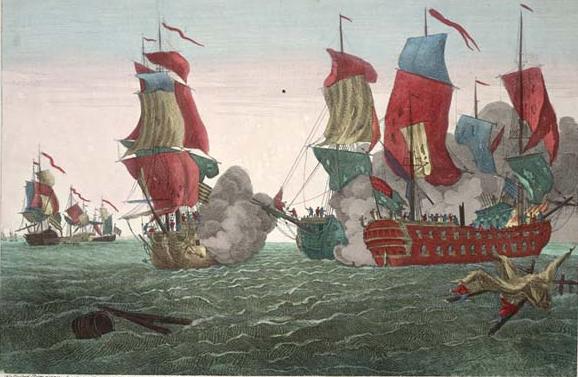“Captain Pearson now called away his boarders and sent them on board the Richard, but, when they had reached her rail, they were met by Jones himself, at the head of a party of pikemen, and driven back.”
Continuing “I Have Not Yet Begun to Fight!”,
our selection from The Life of John Paul Jones by Alexander Slidell Mackenzie published in 1841. The selection is presented in seven easy 5 minute installments. For works benefiting from the latest research see the “More information” section at the bottom of these pages.
Previously in “I Have Not Yet Begun to Fight!”
Time: September 23, 1779
Place: North Sea off Flambough Head, Yorkshire, Great Britain

Public Domain Image From Wikipedia.
Captain Pearson now called away his boarders and sent them on board the Richard, but, when they had reached her rail, they were met by Jones himself, at the head of a party of pikemen, and driven back. They immediately returned to their ship, followed by some of the Richard’s men, all of whom were cut off.
About the same time that the gunner set up his cry for quarter, the master-at-arms, who had been in consultation with the gunner and the carpenter in regard to the sinking condition of the ship, hearing the cry for quarter, proceeded, without orders from Jones, and either from treachery or the prompting of humane feelings, to release all the prisoners, amounting to more than a hundred. One of these, being the commander of the letter-of-marque Union, taken on August 31st, passed, with generous self-devotion, through the lower ports of the Richard and the Serapis, and, having reached the quarter-deck of the latter, informed Captain Pearson that if he would hold out a little longer the Richard must either strike or sink; he moreover informed him of the large number of prisoners who had been released with himself, in order to save their lives. Thus encouraged, the battle was renewed from the Serapis with fresh ardor.
The situation of Jones at this moment was indeed hopeless beyond anything that is recorded in the annals of naval warfare. In a sinking ship, with a battery silenced everywhere, except where he himself fought, more than a hundred prisoners at large in his ship, his consort, the Alliance, sailing round and raking him deliberately, his superior officers counseling surrender, while the inferior ones were setting up disheartening cries of fire and sinking and calling loudly for quarter–the chieftain still stood undismayed. He immediately ordered the prisoners to the pumps, and took advantage of the panic they were in, with regard to the reported sinking of the ship, to keep them from conspiring to overcome the few efficient hands that remained of his crew.
Meanwhile the action was continued with the three light quarter-deck guns, under Jones’ immediate inspection. In the moonlight, blended with the flames that ascended the rigging of the Serapis, the yellow main-mast presented a palpable mark, against which the guns were directed with double-headed shot. Soon after ten o’clock the fire of the Serapis began to slacken, and at half-past ten she struck.
Mr. Dale, the first lieutenant of the Richard, was now ordered on board the Serapis to take charge of her. He was accompanied by Midshipman Mayrant and a party of boarders. Mr. Mayrant was run through the thigh with a boarding-pike as he touched the deck of the Serapis, and three of the Richard’s crew were killed, after the Serapis had struck, by some of the crew of the latter who were ignorant of the surrender of their ship.
Lieutenant Dale found Captain Pearson on the quarter-deck, and told him he was ordered to send him on board the Richard. It is a remarkable evidence of the strange character of this engagement, and the doubt which attended its result, that the first lieutenant of the Serapis, who came upon deck at this moment, should have asked his commander whether the ship alongside had struck. Lieutenant Dale immediately answered: “No, sir; on the contrary, he has struck to us!”
The British lieutenant, like a true officer, then questioned his commander, “Have you struck, sir?” Captain Pearson replied, “Yes, I have!” The lieutenant replied, “I have nothing more to say,” and was about to return below, when Mr. Dale informed him that he must accompany Captain Pearson on board the Richard. The lieutenant rejoined, “If you will permit me to go below, I will silence the firing of the lower-deck guns.” This offer Mr. Dale very properly declined, and the two officers went on board the Richard and surrendered themselves to Jones.
Pearson, who had risen, like Jones, from a humble station by his own bravery, but who was as inferior officer to Jones in courtesy as he had proved himself in obstinacy of resistance, evinced from the first a characteristic surliness, which he maintained throughout the whole of his intercourse with his victor. In surrendering he said that it was painful for him to deliver up his sword to a man who had fought with a halter around his neck. Jones did not forget himself, but replied with a compliment, which, though addressed to Pearson, necessarily reverted to himself, “Sir! you have fought like a hero, and I make no doubt but your sovereign will reward you in a most ample manner.”
| <—Previous | Master List | Next—> |
More information here.
Like!! Really appreciate you sharing this blog post.Really thank you! Keep writing.